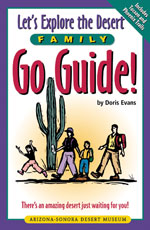
Supplement for Family Go Guide
Desert Poetry
You may think you can't write poetry, but you can! All it takes is observing your surroundings, and thinking about what you see, hear, and feel. Poems do not have to rhyme. Trying to find rhyming words sometimes gets in the way of your thoughts.
Growing a Poem
Here's how to "grow a poem". The chart will help you.
- In the first column are the words see, hear, feel, smell, where I am, weather.
- In the second column write one word on each line that tells what you see, hear, smell and feel.
- In the third column write a thought ending with the word you wrote in the second column. You can change the form of the word (add and "s," "ing," or "ed" to your word).
Here's a sample of how it works. A northern scene is used in this sample so it won't take any ideas you may have about the desert scene.
| see | trees | I look up at the tall, green trees |
| hear | birds | Hiding there are singing birds |
| smell | leaves | The air smells of the fallen leaves |
| feel | breeze | I feel a soft breeze |
| where I am | woods | It's fun to walk in the woods |
| weather | cool | Shady, dark, and cool. |
Got the idea? Now put together your poem. Let your senses and the natural surroundings inspire you.
Name Poem
Each letter of a desert word is used as the initial letter for a line of the poem. The poem doesn't need to rhyme.
Example:
Can't touch,
Always stickery.
Careful!
Tough, green skin,
Uses little water,
Spines instead of leaves.
Poetry Patterns
These are poems written in
the shape of the poem's main idea.
They do not have to rhyme.
Haiku
This is an unrhymed Japanese poem of three structured lines. It is usually light and delicate and is about something lovely in nature. Sometimes, there is a direct contrast within the verse.
Structure: line 1 - 5 syllables
line 2 - 7 syllables
line 3 - 5 syllables
Example:
Coyote howls a call
His brother barks an answer
The moon shines brightly
Couplet
This simple poem consists of two rhyming lines. It often contains a humorous twist.
Example:
Hawk, I watch you soar the sky.
Oh, I wish I, too, could fly.
Cinquain
This is a five-line verse form.
Structure: line 1 - one word of 2 syllables (may be the title)
line 2 - 4 syllables (describing the subject or title)
line 3 - 6 syllables (showing action)
line 4 - 8 syllables (expressing a feeling or observation about the subject)
line 5 - 2 syllables (describing or renaming the subject)
Example:
Bursage
Small grey-green shrub
Shelters young saguaro
Few know your name or who you are
Nurse plant










